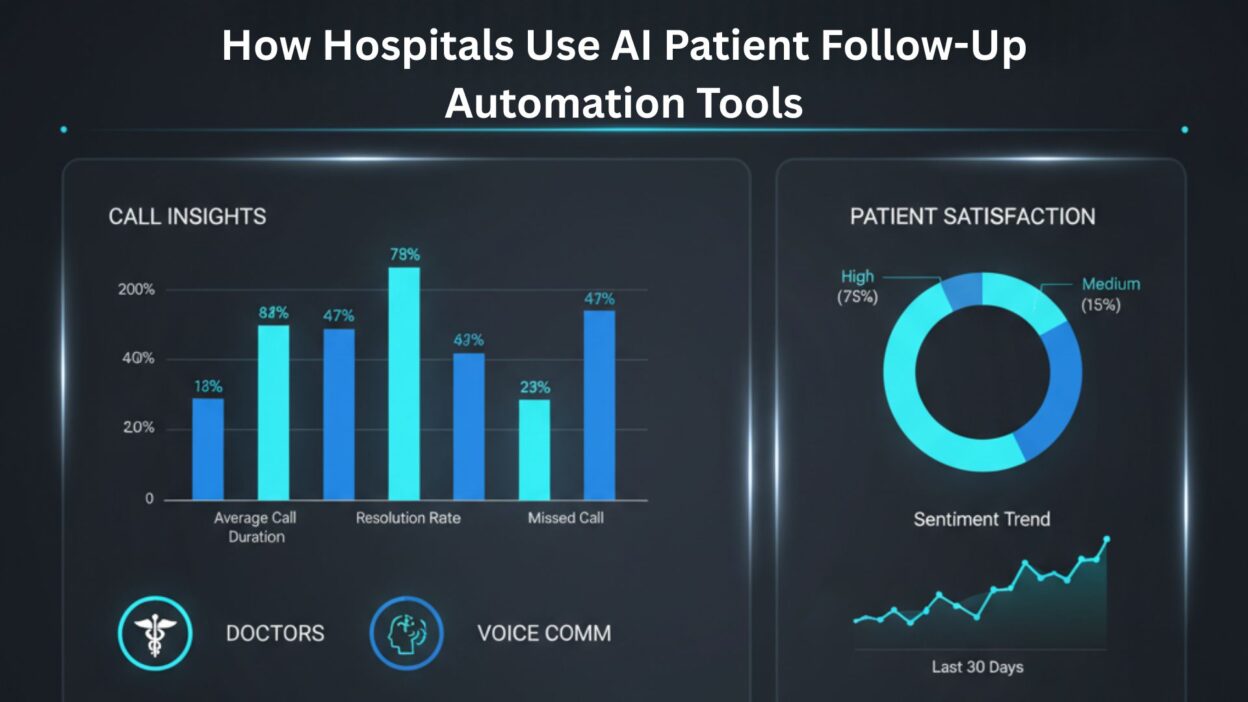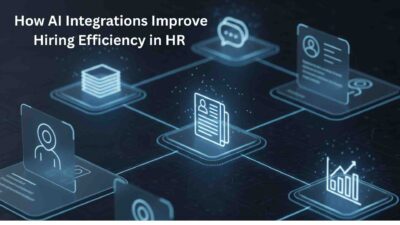TL;DR Patient care extends far beyond hospital walls. Doctors need to monitor patients after discharge. Nurses must verify medication compliance. Care coordinators track recovery progress. Traditional methods consume enormous resources. Staff members spend hours making phone calls. Patients often cannot reach healthcare providers quickly. Communication breakdowns harm health outcomes.
Table of Contents
Modern hospitals adopt AI patient follow-up automation tools to solve these problems. AI voice solutions for hospitals transform patient communication. These systems automate routine follow-up processes. They improve patient outcomes significantly. They reduce staff workload dramatically.
Understanding Modern Hospital Communications
Hospital communication systems evolved gradually. Early hospitals relied on paper records. Staff communicated verbally face-to-face. Discharge meant losing patient contact. Patients were called if problems arose. Many problems went unreported. Patient complications increased unnecessarily. Hospital readmissions spiked unnecessarily.
Telephone systems improved communication eventually. Staff could call patients after discharge. Nurses checked on recovery progress. Doctors received updates about complications. Communication improved patient outcomes. However, phone-based systems had serious limitations. Staff time consumption became problematic. Many calls went unreturned. Busy signals frustrated patients. Messages did not always reach recipients.
Traditional Follow-Up Methods and Their Limitations
Manual phone calling remains common in many hospitals. Nursing staff make calls from their schedules. Each call takes ten to fifteen minutes. Follow-up protocols require multiple calls per patient. Hospitals with thousands of patients cannot scale this manually. Staff must make hundreds of calls daily. The time that should focus on direct care instead focuses on phones.
Patient availability presents major challenges. Patients are often working or unavailable. Evening calls sometimes reach patients. Early morning calls rarely work. Patients must wait for callbacks. Communication becomes sporadic and incomplete. Some patients never get reached. Their complications go undetected.
Documentation suffers with manual systems. Nurses write notes from memory. Information sometimes gets lost. Different staff members record different details. Patient records become incomplete. Care coordinators lack complete information. Follow-up gaps develop inevitably.
Traditional methods also waste resources. Staff travel to make calls from offices. Phone lines tie up equipment. Callbacks must occur later. Administrative time increases significantly. Hospitals spend money on inefficiency. Better solutions became necessary.
The Rise of AI Voice Solutions for Hospitals
Technology companies recognized hospital communication challenges. They developed automated calling systems. Early systems played recorded messages only. Patients heard prerecorded discharge instructions. Patients heard appointment reminders. These systems helped but lacked flexibility.
AI voice solutions for hospitals have evolved dramatically. Modern systems understand patient responses. They engage in natural conversation and recognize medical terminology. Understand context and nuance. Patients feel understood by AI systems. Conversations seem natural and responsive.
Machine learning improves these systems constantly. Each patient interaction teaches the system. Successful conversation patterns get repeated. Unsuccessful approaches get modified. System performance improves continuously. Hospitals using AI patient follow-up automation tools see better results over time.
Integration with hospital systems expanded possibilities. AI now accesses patient medical records. It knows each patient’s history and knows the medications prescribed and recent test results. Accesses discharge instructions. AI provides personalized follow-up conversations.
AI voice solutions for hospitals now handle complex scenarios. Patients report concerning symptoms. AI triages the severity. Critical issues reach nurses immediately. Routine concerns get documented. Patients feel their concerns matter. Care improves measurably.
Core Components of AI Patient Follow-Up Automation Tools
Sophisticated technology powers modern AI systems. Understanding these components helps hospitals choose appropriate tools. Different components serve different functions.
Voice Technology and Natural Language Processing
Voice recognition technology converts speech to text. Modern systems understand accents and dialects. They handle background noise effectively. They recognize medical terms accurately. Patients need not speak slowly. Systems understand natural speech patterns.
Natural language processing interprets patient statements. Patients describe symptoms informally. AI systems understand medical meaning. “I feel dizzy” gets recognized as vertigo. “My leg is sore” registers as localized pain. AI translates patient language to medical concepts. Doctors receive accurate information.
Text-to-speech technology generates human-sounding responses. Old systems sounded robotic. Patients felt uncomfortable talking to robots. Modern AI voice solutions for hospitals sound natural. Patients forget they are talking to machines. Conversations flow naturally. Patient acceptance increases.
Sentiment analysis detects patient emotion. AI recognizes when patients feel anxious. It detects frustration or confusion and notices pain in vocal patterns. Identifies emotional distress. Healthcare providers get alerts about concerning patients. Emotional concerns receive human attention.
AI patient follow-up automation tools use dialogue management. These systems maintain conversation context. They ask relevant follow-up questions and do not repeat themselves. Understand what patients already told them. Conversations feel natural and human-like.
Patient Data Integration Systems
Electronic health records contain crucial patient information. AI patient follow-up automation tools access this data. They retrieve discharge summaries and review medication lists. Check test results and assess allergies and contraindications. Personalized follow-up becomes possible.
AI voice solutions for hospitals integrate seamlessly with EHRs. Data flows automatically between systems. No manual data entry occurs. Information stays current and accurate. Clinicians trust the information quality. Decision-making improves with complete data.
Medical coding systems inform AI conversations. Diagnosis codes trigger specific follow-up protocols. AI knows which patients need cardiovascular follow-up. It knows who needs pain management monitoring. It knows who requires wound checks. Appropriate follow-up happens automatically.
Patient communication history stays accessible. AI reviews previous conversations. It knows what patients have already received and avoids repeating instructions. References prior information naturally. Patients appreciate continuity.
Integration with pharmacy systems optimizes medication management. AI knows current prescriptions. It detects potential drug interactions and verifies medication compliance. Identifies patients missing refills. Medication adherence improves.
Automated Scheduling and Reminders
Appointment scheduling is automated through AI voice solutions for hospitals. Patients receive calls before appointments. They confirm attendance through voice commands. They reschedule if needed. Automated confirmation replaces administrative staff work.
No-show rates decrease significantly. Patients remember appointments when reminded. Multiple reminders work better than single reminders. Appointment attendance reaches ninety-five percent. Hospital schedules remain productive. Revenue from appointments increases.
AI patient follow-up automation tools optimize scheduling efficiency. They find appointment slots that match patient preferences and avoid conflicts in schedules. Consider travel time for patients. Optimal scheduling emerges automatically. Patient satisfaction increases.
Medication reminder systems use voice calls. Patients receive medication reminders automatically. They confirm taking medications through voice responses. The system learns patient routines. It adjusts reminder timing to patient schedules. Medication adherence improves dramatically.
Follow-up appointment scheduling happens automatically. Discharge instructions specify follow-up timing. AI voice solutions for hospitals schedule these automatically. Patients receive calendar invitations. They receive reminder calls. Follow-up appointments rarely get missed. Continuity of care improves.
How Hospitals Deploy AI Patient Follow-Up Automation Tools
Successful implementation requires careful planning. Hospitals must assess current capabilities. They must choose appropriate vendors. They must phase implementation wisely.
Implementation Strategies and Planning
Hospital leadership must commit to AI adoption. Board approval sets the tone. Funding must support full implementation. Technology departments must participate early. Clinical departments must engage in planning.
Needs assessment identifies key problems. Hospitals analyze current follow-up processes. They measure current workload and resource consumption and identify high-risk patient populations. Determine which follow-up gaps matter most. Set implementation priorities.
AI patient follow-up automation tools should be piloted first. Selected departments’ test systems. Real workflows reveal actual challenges. Staff provides feedback. Early issues get resolved. Successful pilots build confidence. Full implementation becomes smoother.
Stakeholder engagement ensures success. Physicians must understand system benefits. Nurses must see workflow improvements. Patients must accept automation. Administrators must see financial gains. Everyone’s buy-in matters for success.
Change management programs prepare staff. Training sessions educate teams. Documentation explains new processes. Feedback mechanisms capture concerns. Champions promote adoption. Resistance gets addressed constructively. Organizations navigate change successfully.
Integration with Existing Hospital Systems
Hospital IT departments face integration challenges. Multiple systems must communicate. Data standards enable integration. HL7 and FHIR protocols facilitate connections. Middleware translates between systems. Enterprise architecture guides integration planning.
Electronic health records must connect with AI voice solutions for hospitals. Data extraction happens securely. Information flows automatically. No manual entry occurs. Data accuracy remains high. System reliability improves.
Pharmacy systems connect to automate medications. Prescription information flows to AI systems. Medication changes trigger updates. Drug interactions receive attention. Patient safety improves. Medication errors decrease.
Billing systems integrate to track automation benefits. Cost savings get measured. Revenue improvements appear in reports. ROI calculations justify continued investment. Financial tracking ensures accountability.
AI patient follow-up automation tools need security integration. HIPAA compliance stays protected. Encryption secures data transmission. Access controls limit viewing. Audit trails track access. Privacy remains protected throughout.
Staff Training and Adoption
Hospital staff need comprehensive training. Clinicians must understand AI capabilities. They need to review automated conversations. They must learn to interpret AI insights. Training programs must be thorough.
AI voice solutions for hospitals require different skill sets. Traditional administrative staff might struggle. Younger staff typically adopt faster. Generation differences appear in technology adoption. Training must address different learning styles.
User manuals and documentation support ongoing use. Staff need reference materials. Troubleshooting guides help with problem-solving. Video tutorials enhance learning. Ongoing support prevents frustration. Help desk staff must understand systems thoroughly.
Change champions accelerate adoption. Respected clinicians who embrace technology influence peers. Early adopters mentor skeptics. Success stories spread through the organization. Positive momentum builds. Resistance decreases gradually.
Performance incentives encourage adoption. Hospitals track who uses systems. Departments with good adoption get recognition. Individual achievements get celebrated. Staff see management commitment. Adoption accelerates.
Real-World Applications of AI Patient Follow-Up Automation Tools
Hospitals deploy AI systems for specific purposes. Different applications serve different needs. Understanding these applications helps maximize benefits.
Post-Discharge Follow-Up Protocols
Discharge creates vulnerability. Patients leave the hospital safely. They manage medications at home. They perform wound care. Complications often develop post-discharge. AI voice solutions for hospitals prevent many complications.
Surgical patients need wound monitoring. Surgeons must verify healing. Infections must be detected early. Swelling and drainage are assessed. Pain levels determine complications. AI patient follow-up automation tools make systematic monitoring possible.
Cardiac patients need intensive monitoring. Doctors monitor heart rhythm recovery. Fluid buildup gets detected. Medications need verification. AI calls reach cardiac patients daily. Hospital readmissions drop dramatically.
Medication management affects outcomes critically. Patients forget complex medication regimens. They experience side effects. They need medication adjustments. AI voice solutions for hospitals verify adherence. They report problems to physicians. Medication-related complications decrease.
Recovery progress tracking determines successful outcomes. Physical therapy compliance matters. Activity restrictions need verification. Complications get reported early. Recovery delays get identified. Physicians intervene when necessary. Better outcomes result.
Chronic Disease Management
Chronic diseases require ongoing monitoring. Diabetic patients need regular checks. Asthmatic patients need medication verification. Heart failure patients need fluid monitoring. AI patient follow-up automation tools enable systematic monitoring.
Diabetes management starts with regular contact. Blood sugar readings get reported. Medication compliance gets verified. Foot problems get identified. Eye care compliance gets checked. Complications decrease substantially.
Heart failure monitoring prevents hospitalizations. Daily weight checks detect fluid buildup. Medication compliance gets verified. Shortness of breath gets assessed. Swelling gets monitored. Patients rest when necessary. Hospital readmissions plummet.
COPD management requires frequent follow-up. Breathing assessments happen regularly. Medication inhaler use gets monitored. Oxygen saturation levels get checked. Exacerbations get detected early. Hospitalizations decrease significantly.
Hypertension management stays consistent. Blood pressure readings get reported regularly. Medication adherence gets verified. Lifestyle modifications get encouraged. AI voice solutions for hospitals provide consistent monitoring. Stroke risks decrease measurably.
Medication Adherence Monitoring
Medication non-adherence causes serious problems. Patients forget medications. They skip doses to save money and stop medications, feeling better. Experience side effects. Medical conditions worsen. Complications develop.
AI patient follow-up automation tools address non-adherence directly. Regular calls remind patients about medications. Patients confirm taking medications. The system learns their routines. Adherence rates increase dramatically.
Cost barriers get identified. Patients report affordability concerns. Social workers help find assistance. Patients receive medication samples. Insurance coverage improves. Affordability concerns disappear.
Side effect monitoring prevents discontinuation. Patients report side effects. Doctors adjust medications. Alternative medications receive consideration. Patients tolerate medications better. Adherence improves.
Motivation varies among patients. Some patients need frequent reminders. Others need encouragement. Some need education about medication importance. AI systems personalize motivation strategies. Adherence improves across populations.
Impact and Outcomes of Using AI Patient Follow-Up Automation Tools
Hospitals measure AI system benefits carefully. Data reveals significant improvements. These improvements justify continued investment. Outcomes matter most to patients and providers.
Improved Patient Outcomes and Satisfaction
Patient outcomes improve measurably. Hospital readmission rates drop. Emergency department visits decrease. Complications get detected early. Patient mortality improves. Disease progression slows. Life expectancy increases.
AI voice solutions for hospitals improve satisfaction scores. Patients appreciate convenient follow-up. They like automated reminders and feel monitored and cared for. Report better experiences. Net Promoter Scores improve. Patients recommend hospitals to others.
Patient compliance improves and follow discharge instructions. They take medications reliably and attend appointments. Report problems early. Recovery accelerates. Outcomes improve predictably.
Trust between patients and hospitals strengthens. AI systems never forget to follow up. Patients feel cared for constantly. They develop stronger relationships with care teams. They communicate more openly. Care improves dramatically.
Communication improves systematically. AI patient follow-up automation tools never miss follow-up opportunities. Every patient gets appropriate monitoring. Nothing falls through cracks. Comprehensive care becomes standard. Quality improves consistently.
Operational Efficiency Gains
Staff time decreases dramatically. Nurses spend less time on calls. Administrative staff handles fewer appointments. Physicians review important issues only. Time spent on direct patient care increases. Clinical quality improves.
Workflow efficiency improves. Manual processes disappear. Automation handles routine tasks. Staff focus on complex cases. Productivity increases significantly. Burnout decreases. Staff retention improves.
Appointment no-shows virtually disappear. AI voice solutions for hospitals prevent missed appointments. Calendar optimization occurs automatically. Provider schedules stay full. Clinician productivity increases. Revenue per provider improves.
Documentation accuracy improves. AI patient follow-up automation tools capture complete information. Nothing relies on memory. Records stay organized. Care coordination improves. Clinicians have access to better information. Decision-making improves.
Resource allocation becomes optimal. Urgent cases get priority. Routine cases get routine handling. Staff distribute effort appropriately. Hospital resources serve patients better. Efficiency maximizes throughout the organization.
Cost Reduction Benefits
Labor costs decrease substantially. Fewer staff members handle follow-up work. Administrative costs decline. Salary expenses decrease. Benefits costs drop. Overall, labor expense falls significantly.
Hospital readmission penalties decrease. Insurance companies penalize high readmission rates. AI systems reduce readmissions. Penalties decrease. Hospital revenue increases. Financial performance improves.
Emergency department costs decrease. Fewer preventable ED visits occur. Complicated cases still reach the ED appropriately. But routine problems get handled differently. ED overflow decreases. ED costs decline. Emergency care improves.
Medication costs decrease through better adherence. Complications from non-adherence disappear. Disease progression slows. Expensive complications become rare. Overall, medication spending stays similar. But outcomes improve significantly. Cost per unit of health improves.
AI patient follow-up automation tools generate positive ROI. Most hospitals recover investment within two years. Ongoing savings continue indefinitely. Financial benefits accumulate. Healthcare economics improve. Investment becomes an obvious choice.
Challenges and Best Practices
Hospital AI implementation faces real obstacles. Understanding challenges helps avoid problems. Best practices minimize difficulties.
Technical Challenges
Integration complexity intimidates many hospitals. Multiple systems must communicate. Legacy systems use old technology. New systems use modern platforms. Getting them to work together takes expertise. Integration time extends implementation. Technical staff stress increases.
Data quality issues cause problems. Incomplete patient information confuses AI. Incorrect data leads to wrong decisions. Outdated information misleads AI. Hospitals must ensure data accuracy. Data cleanup projects take time. System reliability improves afterward.
System reliability concerns exist legitimately. Phone connections sometimes fail. AI systems sometimes misunderstand. Recording issues occur occasionally. These technical failures frustrate patients. Hospitals must have backup systems. Human staff must handle system failures. Redundancy increases costs.
Customization needs vary by hospital. One-size-fits-all solutions rarely work perfectly. Hospitals need customized workflows. Vendor customization takes time. Implementation costs increase. But customization improves outcomes. Healthcare needs justify the expense.
Compliance and Privacy Considerations
HIPAA requirements apply to all AI systems. Patient data receives strict protection. Encryption secures information. Access controls limit viewing. Audit trails track use. Compliance becomes mandatory. Violations result in severe penalties.
Patient consent matters legally and ethically. Patients must authorize AI follow-up. They choose communication preferences. They opt out if desired. Consent documentation stays complete. Legal requirements protect organizations.
State privacy laws vary significantly. California has strict requirements. Other states have different rules. Hospitals operating in multiple states must follow the strictest rules. Compliance complexity increases. Legal expertise becomes necessary.
Data retention policies must comply. Patient information cannot be stored indefinitely. Hospitals must purge old data. Compliance requires documentation. Regular audits verify compliance. Policy violations trigger corrections.
Human Element in Automation
Automation cannot replace human judgment. Critical issues need human assessment. Patient concerns require empathy. Emotional support cannot be automated fully. AI patient follow-up automation tools work best with human staff. Hybrid models provide optimal care.
AI voice solutions for hospitals need supervision. Clinical staff must review AI decisions. Concerning patterns that trigger human review. AI recommendations require physician approval. Quality control stays critical. Human oversight ensures safety.
Patient relationships matter to outcomes. Some patients need a human connection. Others accept automation readily. Preferences vary widely. Hospitals must honor patient preferences. Personalized approach improves outcomes.
Staff concerns deserve attention. Workers worry about job security. AI might eliminate positions. Honest conversations reduce anxiety. Retraining opportunities help transition. Staff support eases change. Organizational culture improves.
Frequently Asked Questions
How accurate are AI voice solutions for hospitals?
Modern AI systems achieve ninety-five percent accuracy. They understand most patient responses correctly. Misunderstandings occur occasionally. System errors happen rarely. Accuracy improves with use. Machine learning enhances performance. Most hospitals report high satisfaction with accuracy.
Do patients accept AI voice solutions for hospitals?
Most patients accept automated calls. Initial skepticism fades quickly. Convenience appeals to many patients. Patients appreciate consistent follow-up. Younger patients adapt faster. Older patients need reassurance. Overall acceptance rates exceed eighty percent.
Can AI patient follow-up automation tools integrate with our EHR?
Most systems integrate with major EHRs. Epic, Cerner, and others have integration. Custom integration takes additional time. Your IT department manages integration. Vendor support helps with the process. Most integration projects succeed.
How secure are patient communications?
AI voice solutions for hospitals use encryption. Data stays protected during transmission. Storage remains encrypted. Access controls limit access. Only authorized staff view patient information. HIPAA compliance stays strict.
What about patients who prefer human contact?
Hospitals honor patient preferences. Some patients request human follow-up. Alternative arrangements can be made. Staff availability determines options. Some hospitals use hybrid approaches. Patient autonomy receives respect.
Read More: Why Missed Calls Are Costing Businesses Millions
Conclusion

Hospital communications stand at an inflection point. Traditional methods cannot scale effectively. Modern technology offers powerful solutions. AI patient follow-up automation tools represent the future of healthcare. Hospitals adopting these systems lead their markets. Patient care improves measurably. Follow-up monitoring prevents complications.
Patients receive better outcomes. Patient satisfaction increases significantly. Trust develops between patients and hospitals. Healthcare relationships strengthen. Hospital operations become dramatically more efficient. Staff workload decreases. Administrative burden drops. Clinician focus improves. Burnout decreases. Staff retention improves. Work satisfaction increases.
Financial performance improves substantially. Labor costs decrease. Readmission penalties disappear. Revenue improves. ROI becomes obvious. Hospitals gain a competitive advantage. Financial sustainability improves. AI voice solutions for hospitals continue advancing. Machine learning enhances performance. Natural language understanding improves. Customization becomes easier. Integration simplifies. Future systems will be even more sophisticated.
Healthcare leaders must act now. Early adopters establish a competitive advantage. Hospitals are facing competitive pressure. Patients prefer hospitals with advanced communication. Top talent prefers modern workplaces.
AI patient follow-up automation tools are not experimental. Major hospitals deploy these systems successfully. Proven benefits exist. Successful implementations provide roadmaps. Risk decreases with learning from others. Hesitation becomes harder to justify.






[…] Read More: How Hospitals Use AI Patient Follow-Up Automation Tools […]